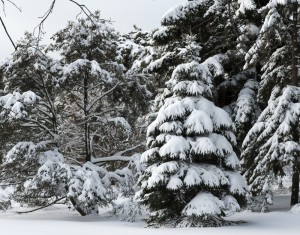Winter Injury Continued
Posted in Gardening Tips, Learning Experiences on January 24 2012, by Sonia Uyterhoeven
 For the past few weeks we have been discussing the fallout of 2011’s strange weather, the damage experienced here at the NYBG, and various methods of identifying at-risk trees. Last week we examined some of the physiological processes behind winter injury.
For the past few weeks we have been discussing the fallout of 2011’s strange weather, the damage experienced here at the NYBG, and various methods of identifying at-risk trees. Last week we examined some of the physiological processes behind winter injury.
Continuing where we left off, we will now explore several things that home owners can do to combat winter injury. The most effective remedy for winter injury on broad-leaved evergreens is prevention; in other words, the best protection is properly siting the plants.
Avoid planting broad-leaved evergreens in exposed, windy sites. It is equally important to avoid planting them on the southern or southwest side of your home. These locations will commonly heat up and reflect light during warm, sunny days in the winter and then plummet back into cold once the evening approaches. Such a rapid change gives the plants mixed signals as to what they should be doing.
Be conscientious with your watering practices, particularly during the fall when the onset of winter approaches. Even though the temperatures at that time of year are starting to cool down, your broad-leaved evergreens are still thirsty. During the cold of winter, be sure to water during dry spells when the temperature rises above freezing.
A final deterrent for winter injury is to build a burlap windbreak to shield the plant from the wind. Some people use anti-desiccants as well, but they seem to get mixed reviews and can do as much harm in some cases as good. If you do experience winter damage on your broad-leaved evergreens, then wait until things warm up in the spring so that you can see all the damage. Often the leaves will be damaged but the buds will be fine. Make sure you don’t make hasty pruning decisions until you assess the damage.
Some plants are more resilient than others. Hollies (Ilex sp.) tend to be amenable to pruning; you can cut them back hard and they will bounce back. If you have a rhododendron or azalea (Rhododendron) that has sustained a substantial amount of injury, many will also respond well to rejuvenation pruning early in the season.
Other evergreens such as mountain laurel (Kalmia latifolia) respond poorly to this kind of pruning, and your best bet is–again–to properly site the plant. Provide a slightly acidic soil for the evergreen, and a protected growing location. Gardening is a learning process, so the best way to discover how to avoid and manage winter injury is to learn from experience. Sometimes stepping out in the spring to make judicious pruning cuts to damaged trees is the best way to understand which of your trees are at risk and what you’re looking for.

